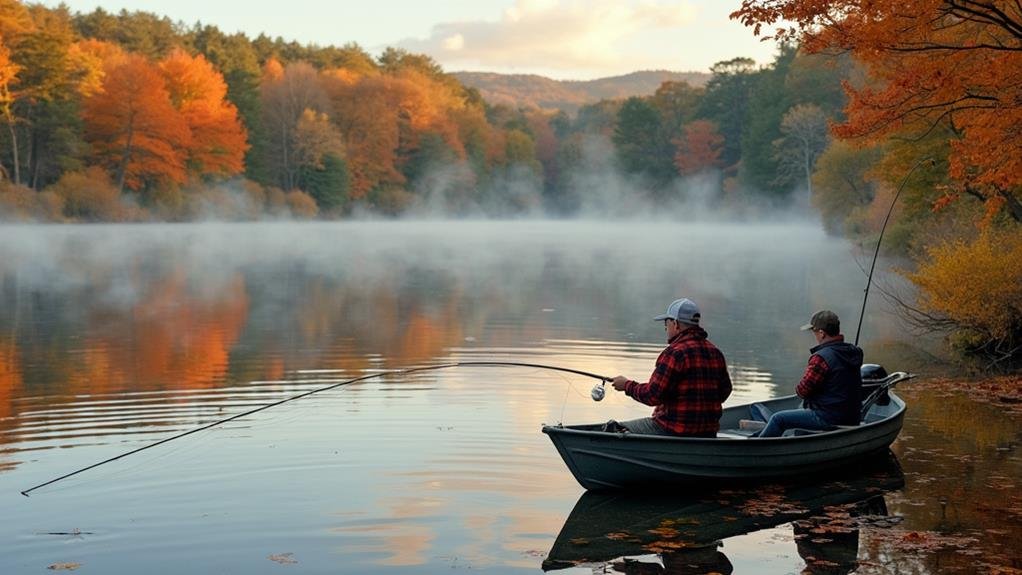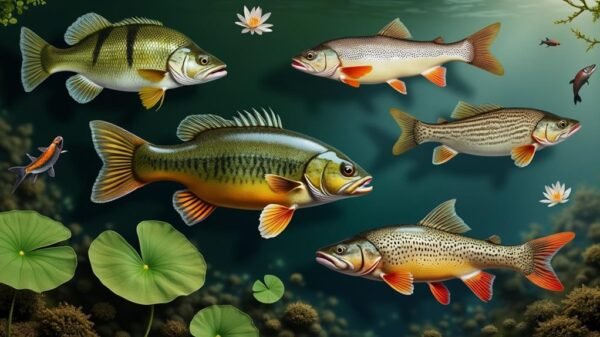To master freshwater fishing by season, you need to adjust your strategies. In spring, target shallow waters and use lighter tackle. Fish are active and feeding, especially near fallen trees. Summer brings heat; fish move to cooler depths, so opt for live bait or topwater lures. Come autumn, prepare for aggressive fish like bass and trout in shallow waters; imitate baitfish with your lures for best results. In winter, focus on deeper waters where fish gather and be patient, as they're less active. Each season offers unique insights, and there's always more to uncover about fishing success!
Understanding Seasonal Changes
Understanding seasonal shifts in freshwater habitats is vital for effective angling. Each season introduces unique conditions that influence fish behavior, water warmth, and food sources. In spring, as temperatures climb, fish become more active, migrating to shallow waters to spawn. Anglers should focus on fishing near shorelines and in coves to maximize their chances. Additionally, understanding elements like water clarity and insect hatches can significantly enhance your fishing tactics during this season.
When summer heat sets in, fish retreat to deeper, cooler zones. They often hide near submerged structures, seeking refuge and nourishment. During this period, early morning or late evening fishing can produce excellent results, as fish tend to feed when the sun's intensity wanes.
As autumn approaches, fish begin to bulk up for winter. This creates an excellent opportunity for anglers, as fish often gather in large schools. They exhibit more aggressive feeding behavior, so experimenting with various baits and lures can help you discover what attracts them most effectively.
Spring Fishing Strategies

As temperatures rise and the ice melts, spring becomes an ideal time for anglers eager to catch fish that are on the move. During this season, fish, such as bass and crappie, are actively feeding after the winter months, creating a perfect opportunity to reel in a trophy. Focus on shallow waters where species gather to spawn, particularly around structures like fallen trees or rocky areas, as these provide cover and attract fish.
In Florida, lakes like Lake Okeechobee and rivers such as the St. Johns River are home to various freshwater fish species that are particularly active this time of year. Use lighter tackle, such as Shimano rods and reels, to enhance your chances—spring fish can be more cautious. Live bait, such as worms or minnows, often yields great results. Don't forget to try using topwater lures, like the Heddon Super Spook, during early mornings or late evenings when fish are more active.
Pay attention to weather patterns. A warm, sunny day can trigger aggressive behavior in fish, while overcast days may require a slower presentation. Keep moving until you find the right spot; don't hesitate to change locations if you're not getting bites.
Lastly, remember to be patient. Spring fishing can be unpredictable, but the excitement of catching a hungry fish makes it all worthwhile. Embrace the freedom of the outdoors and enjoy every moment on the water.
Summer Fishing Techniques

During the summer season, fishing techniques require adjustments due to rising water temperatures and fish behavior. As sunlight warms the water, species such as bass and trout often retreat to cooler areas, including deeper depths or shaded locations. Focus on early mornings or late evenings when temperatures are more favorable. Seek out shaded zones beneath trees or cast near underwater structures like rocks and aquatic plants, which attract various fish species.
For bait selection, opt for live worms, minnows, or topwater lures like the Rebel Pop-R. These offerings can draw fish during their active feeding periods. Adjust your retrieve speed; a slow presentation may work effectively, while a rapid retrieve can provoke aggressive strikes.
Keep your fishing gear lightweight. A medium-action rod paired with a Shimano spinning reel will provide better control and enhance your fishing experience. This setup allows you to enjoy the thrill of the catch while maintaining comfort.
Stay hydrated and protect yourself from harmful UV rays. Fishing should be a tranquil activity, so embrace the joy of being outdoors. With these summer fishing techniques in your arsenal, you're prepared for exciting catches. Relish the thrill of the pursuit, and remember that each outing presents a chance to expand your knowledge.
Autumn Fishing Approaches

As the daylight hours diminish and temperatures drop, autumn fishing presents an exceptional chance to pursue lively species like bass, pike, and trout as they prepare for the winter months. During this period, these fish become more aggressive, necessitating adjustments to your fishing techniques. Grasping the elements that influence freshwater angling can enhance your strategy.
Begin by targeting shallow waters where fish actively seek their final meals before winter's chill. Utilize lures that imitate baitfish, such as Strike King spinnerbaits or Rapala crankbaits, to draw them in. The early morning and late afternoon hours are optimal, as fish tend to forage during these cooler times. Pay attention to weather conditions; cloudy days often yield fantastic fishing since fish feel more secure in subdued light.
Explore various aquatic environments, as different lakes and rivers exhibit diverse temperatures and conditions. When fishing in a river, seek eddies and areas with reduced current where fish may be concealing themselves. Autumn fishing is about more than just catching fish; it's about reveling in nature's stunning transformation. So gather your tackle, embrace the crisp air, and fully enjoy this vibrant season.
Winter Fishing Methods

When winter arrives, anglers should prepare for unique fishing chances that can yield significant rewards. The chilly season may appear daunting, yet it can deliver some of the finest catches. To start, consider ice fishing. This technique allows you to fish directly on frozen bodies of water. Ensure you have essential equipment, such as a StrikeMaster auger to create holes and a Clam shelter to keep warm. During winter, fish activity diminishes, so recognizing seasonal changes can enhance your ability to target specific species effectively.
If ice fishing isn't your preference, bank fishing or boat fishing may still be viable options, depending on local regulations. Concentrate on locating deeper waters where species like largemouth bass and rainbow trout often congregate for warmth. During winter months, these fish are generally less active, so slow down your bait presentation. Utilize jigs or live bait from brands like Berkley, and practice patience; bites may be infrequent, but they can be rewarding.























